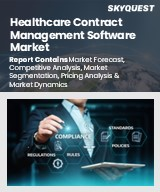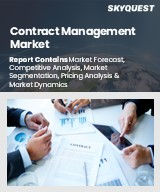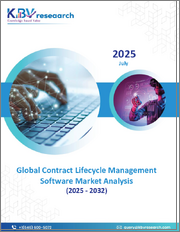
|
시장보고서
상품코드
1660745
계약 수명주기 관리 소프트웨어 시장 보고서 : 전개 모델별, CLM 제공별, 기업 규모별, 산업별, 지역별(2025-2033년)Contract Lifecycle Management Software Market Report by Deployment Model, CLM Offerings, Enterprise Size, Industry, and Region 2025-2033 |
||||||
계약 수명주기 관리 소프트웨어 세계 시장 규모는 2024년 23억 달러에 달했습니다. 향후 IMARC Group은 이 시장이 2033년까지 54억 달러에 달할 것으로 예상하며, 2025년부터 2033년까지 9.7%의 연평균 성장률(CAGR)을 보일 것으로 전망하고 있습니다. 이 시장은 여러 이해관계자, 변수, 종속성을 수반하는 복잡한 문서와 같은 계약의 복잡성 증가와 생산성 향상 및 비용 절감을 위한 계약 관련 업무 간소화에 대한 관심이 높아짐에 따라 꾸준한 성장세를 보이고 있습니다.
계약 수명주기 관리 소프트웨어 시장 분석:
시장 성장과 규모 : 법규의 변화로 인해 계약이 복잡해지고, 법적 리스크 감소에 대한 관심이 높아지면서 시장은 강력한 성장세를 보이고 있습니다.
기술 발전 : 인공지능(AI), 머신러닝(ML) 등 첨단 기술을 계약 라이프사이클 관리(CLM) 소프트웨어에 통합하여 계약 분석을 자동화하고 의사결정을 개선하는 것이 시장 성장을 촉진하고 있습니다.
산업별 용도 : CLM 소프트웨어는 헬스케어, 금융, 제조 등 다양한 산업에서 적용되고 있습니다. 또한, 산업별 솔루션이 고유한 요구사항을 충족하고 산업별 규제 준수를 보장하는 산업별 맞춤형 솔루션을 제공합니다.
지역별 동향 : 북미는 데이터 프라이버시에 대한 관심이 높아지면서 시장을 주도하고 있습니다. 그러나 아시아태평양은 다수의 CLM 소프트웨어 제공업체가 존재하면서 급성장하는 시장으로 부상하고 있습니다.
경쟁 상황 : 주요 업체들은 기능, 기능, 사용자 경험을 강화하여 CLM 소프트웨어 개선에 집중하고 있습니다. 또한 인공지능(AI), 머신러닝(ML) 등의 기술을 활용하여 계약 분석을 자동화하고 가치 있는 인사이트를 제공하고 있습니다.
도전과 기회 : 이 시장은 데이터 보안에 대한 우려와 같은 도전과제에 직면하고 있지만, 다양한 산업에서 CLM 소프트웨어 통합이라는 기회도 있습니다.
향후 전망 : 계약 라이프사이클 관리 소프트웨어 시장의 미래는 데이터 기반 의사결정에 대한 요구가 증가함에 따라 유망할 것으로 예상됩니다. 또한, 효율성 유지에 대한 관심이 높아지고 있는 점도 시장 성장을 촉진할 것으로 예상됩니다.
계약 수명주기 관리 소프트웨어 시장 동향:
계약의 복잡성
조직 내 계약의 복잡성 증가에 따른 CLM 소프트웨어에 대한 수요 증가는 시장 전망을 밝게 하고 있습니다. 이에 따라 계약은 단순한 합의에서 여러 이해관계자, 변수, 종속관계를 포함하는 복잡한 문서로 진화하고 있습니다. 이러한 복잡성은 세계화, 다양한 제품 제공, 역동적인 규제 환경 등의 요인에 기인합니다. CLM 소프트웨어는 계약서 작성, 추적, 모니터링을 위한 중앙 집중식 플랫폼을 제공함으로써 이러한 복잡한 계약을 관리하는 데 매우 중요한 역할을 하고 있으며, CLM 소프트웨어는 계약서 템플릿 표준화, 일관된 언어 보장, 승인 프로세스 자동화에 도움을 주며 시장 성장을 촉진하고 있습니다. 이 외에도 CLM 소프트웨어는 조직이 법적 요구 사항과 비즈니스 요구 사항을 계약에 쉽게 통합하여 오해와 분쟁의 위험을 줄일 수 있도록 도와줍니다. 또한 CLM 소프트웨어는 운영을 간소화할 뿐만 아니라 투명성과 책임성을 강화하기 때문에 복잡한 현대 계약을 탐색하려는 기업에게 귀중한 도구가 되고 있습니다.
규제 준수
규제 준수를 위해 CLM 소프트웨어의 채택이 증가하고 있는 것이 시장 성장에 기여하고 있습니다. 이에 따라 전 세계 산업계는 데이터 프라이버시 법에서 산업별 규제에 이르기까지 끊임없이 진화하는 규제와 표준에 직면하고 있습니다. CLM 소프트웨어는 자동 컴플라이언스 점검, 버전 관리, 감사 추적 등의 기능을 제공하여 조직이 이러한 규제를 준수할 수 있도록 지원합니다. 또한, 계약서가 법적 요건을 충족하고 법률 및 규정의 변경 사항을 반영하여 계약서가 업데이트되도록 보장합니다. 이는 비용이 많이 드는 법적 처벌을 피하고 윤리적이고 책임감 있는 관행에 대한 명성을 유지하는 데 매우 중요합니다. 이 외에도 CLM 소프트웨어는 규제 당국에 컴플라이언스를 증명하는 데 필요한 보고서와 문서를 작성하는 데 도움을 주며, 컴플라이언스 보고의 복잡한 작업을 간소화합니다. 또한 CLM 소프트웨어는 모든 계약의 중앙 집중식 저장소를 제공하여 조직이 계약상의 의무를 쉽게 모니터링하고 관리할 수 있도록 도와줍니다.
계약 관련 업무 효율화에 대한 관심 증가
조직에서 비용 절감에 대한 관심이 높아지면서 시장 성장을 견인하고 있습니다. 이와는 별도로, 수작업에 의한 계약 관리 프로세스는 방대한 서류 작업, 수작업 데이터 입력, 인적 오류를 포함하기 때문에 자원이 집중되고 비효율적일 수 있습니다. 반면 CLM 소프트웨어는 계약 관련 업무를 간소화하고, 워크플로우를 자동화하며, 수작업 개입의 필요성을 줄여주는 장점이 있습니다. 이를 통해 관리 오버헤드를 줄이고, 실수를 최소화하며, 계약 라이프사이클을 가속화함으로써 상당한 비용 절감을 돕습니다. 이에 따라 CLM 소프트웨어는 공급업체와의 조건 재협상, 가격 구조 최적화 등 계약 내 비용 절감 기회를 식별할 수 있습니다. 또한, CLM 소프트웨어의 투자수익률(ROI)은 종종 상당한 수준이며, 효과적인 계약 관리를 원하는 조직에게 매력적인 솔루션이 될 수 있습니다. 또한, CLM 소프트웨어를 통한 계약 관련 업무의 간소화에 대한 관심이 높아짐에 따라 기업은 생산성을 향상시키고 경쟁 환경에 맞게 계약 관리 프로세스를 최적화할 수 있게 되어 시장 성장을 촉진하고 있습니다.
목차
제1장 서문
제2장 조사 범위와 조사 방법
- 조사 목적
- 이해관계자
- 데이터 소스
- 1차 정보
- 2차 정보
- 시장 추정
- 상향식 접근
- 하향식 접근
- 조사 방법
제3장 주요 요약
제4장 소개
- 개요
- 주요 업계 동향
제5장 세계의 계약 수명주기 관리 소프트웨어 시장
- 시장 개요
- 시장 실적
- COVID-19의 영향
- 시장 내역 : 전개 모델별
- 시장 내역 : CLM 제공별
- 시장 내역 : 기업 규모별
- 시장 내역 : 산업별
- 시장 내역 : 지역별
- 시장 예측
제6장 시장 내역 : 전개 모델별
- 클라우드 기반
- 시장 동향
- 시장 예측
- 온프레미스
- 시장 동향
- 시장 예측
제7장 시장 내역 : CLM 제공별
- 라이선싱과 구독
- 시장 동향
- 시장 예측
- 서비스
- 시장 동향
- 시장 예측
제8장 시장 내역 : 기업 규모별
- 대기업
- 시장 동향
- 시장 예측
- 중소기업
- 시장 동향
- 시장 예측
제9장 시장 내역 : 산업별
- 자동차
- 시장 동향
- 시장 예측
- 전기·전자
- 시장 동향
- 시장 예측
- 제약
- 시장 동향
- 시장 예측
- 소매업과 E-Commerce
- 시장 동향
- 시장 예측
- 제조
- 시장 동향
- 시장 예측
- BFSI
- 시장 동향
- 시장 예측
- 기타
- 시장 동향
- 시장 예측
제10장 시장 내역 : 지역별
- 북미
- 시장 동향
- 시장 예측
- 유럽
- 시장 동향
- 시장 예측
- 아시아태평양
- 시장 동향
- 시장 예측
- 중동 및 아프리카
- 시장 동향
- 시장 예측
- 라틴아메리카
- 시장 동향
- 시장 예측
제11장 세계의 계약 수명주기 관리 소프트웨어 산업 : SWOT 분석
- 개요
- 강점
- 약점
- 기회
- 위협
제12장 세계의 계약 수명주기 관리 소프트웨어 산업 : 밸류체인 분석
제13장 세계의 계약 수명주기 관리 소프트웨어 산업 : Porter's Five Forces 분석
- 개요
- 구매자의 교섭력
- 공급 기업의 교섭력
- 경쟁 정도
- 신규 참여업체의 위협
- 대체품의 위협
제14장 세계의 계약 수명주기 관리 소프트웨어 산업 : 가격 분석
제15장 경쟁 구도
- 시장 구조
- 주요 기업
- 주요 기업 개요
- Wolters Kluwer N.V.
- IBM Corporation
- Icertis, Inc.
- SAP SE
- BravoSolution SPA
- Contracked BV
- Contract Logix, LLC
- Coupa Software Inc
- EASY SOFTWARE AG
- ESM Solutions Corporation
- Great Minds Software, Inc.
- Koch Industries, Inc.
- Ivalua Inc
- Optimus BT
- Oracle Corporation
- Symfact AG
- DocuSign, Inc
- Newgen Software Technologies Limited
- Zycus Infotech Private Limited
- Corcentric LLC(Determine)
The global contract lifecycle management software market size reached USD 2.3 Billion in 2024. Looking forward, IMARC Group expects the market to reach USD 5.4 Billion by 2033, exhibiting a growth rate (CAGR) of 9.7% during 2025-2033. The market is experiencing steady growth driven by the rising complexity of contracts like intricate documents with multiple stakeholders, variables, and dependencies and increasing focus on streamlining contract-related tasks to enhance productivity and save costs.
Contract Lifecycle Management Software Market Analysis:
Market Growth and Size: The market is witnessing strong growth on account of the increasing complexity in contracts due to regulatory changes, along with rising focus on mitigating legal risks.
Technological Advancements: The integration of advanced technologies like artificial intelligence (AI) and machine learning (ML) in contract lifecycle management (CLM) software to automate contract analysis and improve decision-making are facilitating market growth.
Industry Applications: CLM software finds applications across various industries, including healthcare, finance, and manufacturing. Moreover, industry-specific solutions cater to unique needs, ensuring compliance with sector-specific regulations.
Geographical Trends: North America leads the market, driven by the increasing focus on data privacy. However, Asia Pacific is emerging as a fast-growing market due to the presence of numerous CLM software providers.
Competitive Landscape: Key players are focusing on improving CLM software by enhancing features, functionality, and user experience. They are also leveraging technologies like artificial intelligence (AI) and machine learning (ML) to automate contract analysis and provide valuable insights.
Challenges and Opportunities: While the market faces challenges, such as data security concerns, it also encounters opportunities in the integration of CLM software in a wide range of industries.
Future Outlook: The future of the contract lifecycle management software market looks promising, with the increasing need for data-driven decision-making. In addition, the rising focus on maintaining efficiency is projected to bolster the market growth.
Contract Lifecycle Management Software Market Trends:
Increasing complexity of contracts
The growing demand for CLM software on account of the rising complexity of contracts in organizations is offering a positive market outlook. In line with this, contracts are evolving from simple agreements to intricate documents with multiple stakeholders, variables, and dependencies. This complexity can be attributed to factors, such as globalization, diverse product offerings, and dynamic regulatory environments. Moreover, CLM software plays a pivotal role in managing these complex contracts by providing a centralized platform for creating, tracking, and monitoring agreements. It helps in standardizing contract templates, ensuring consistent language, and automating the approval process, which is impelling the market growth. Apart from this, CML software enables organizations to easily integrate legal and business requirements into contracts that assist in reducing the risk of misunderstandings and disputes. Furthermore, CLM software not only streamlines operations but also enhances transparency and accountability, which makes it a valuable tool for companies looking to navigate intricate modern contracts.
Regulatory compliance
The rising adoption of CLM software due to regulatory compliance is contributing to the growth of the market. In line with this, industries across the globe are facing an ever-evolving landscape of regulations and standards, ranging from data privacy laws to industry-specific regulations. Moreover, CLM software assists organizations in adhering to these regulations by providing features, such as automated compliance checks, version control, and audit trails. In addition, it ensures that contracts meet legal requirements and are updated to reflect changes in laws and regulations. This is crucial for avoiding costly legal penalties and maintaining a reputation for ethical and responsible practices. Apart from this, CLM software assists in generating reports and documentation needed to demonstrate compliance to regulatory authorities while simplifying the complex task of compliance reporting. Furthermore, CLM software provides a centralized repository for all contracts, which makes it easier for organizations to monitor and manage their contractual obligations.
Rising focus on streamlining contract-related tasks
The increasing focus on cost-savings in organizations is supporting the growth of the market. Apart from this, manual contract management processes involve extensive paperwork, manual data entry, and human errors, that can be resource-intensive and prone to inefficiencies. On the other hand, CLM software benefits in streamlining contract-related tasks, automating workflows, and reducing the need for manual intervention. This assists in significant cost savings by lowering administrative overhead, minimizing errors, and speeding up contract lifecycles. In line with this, CLM software can identify cost-saving opportunities within contracts, such as renegotiating terms with suppliers or optimizing pricing structures. Furthermore, the return on investment (ROI) of implementing CLM software is often substantial, making it an attractive solution for organizations looking to ensure effective contract management. Moreover, the rising focus on streamlining contract-related tasks through CLM software empowers organizations to enhance productivity and optimize their contract management processes for a more competitive environment is impelling the market growth.
Contract Lifecycle Management Software Industry Segmentation:
Breakup by Deployment Model:
- Cloud-Based
- On-Premises
Cloud-based accounts for the majority of the market share
Cloud-based CLM solutions offer improved flexibility, scalability, and accessibility from anywhere with an internet connection. These solutions are increasingly adopted by small and medium-sized enterprises (SMEs) seeking cost-effective and subscription-based models. The cloud-based deployment offers easier updates and maintenance, reducing information technology (IT) overhead for organizations.
On-premises CLM solutions are preferred by large enterprises and industries with strict data security and compliance requirements. They provide organizations with complete control over their data and infrastructure, appealing to those concerned about data privacy and regulatory compliance.
Breakup by CLM Offerings:
- Licensing and Subscription
- Services
Licensing and subscription hold the largest market share
Licensing and subscription involve legal permissions granted to use software or services, often outlined in contracts. They also include regular payments for access to these resources. In addition, effective CLM ensures that organizations can manage their licensing and subscription agreements efficiently and promote transparency and accountability in contractual relationships.
Services in the CLM encompass various professional services offered by vendors and third-party providers to assist organizations in implementing, customizing, and maintaining CLM solutions. These services include implementation services, consulting services, training and support services, and integration services. Additionally, implementation services involve the setup and configuration of the CLM software to meet specific requirements of companies. Consulting services provide expertise on suitable practices in contract management and help organizations optimize their processes. Training and support services offer training sessions and ongoing technical support to ensure that users can effectively utilize the CLM software.
Breakup by Enterprise Size:
- Large Enterprise
- Small and Medium Enterprise
Large enterprise represents the leading market segment
Large enterprise is characterized by significant resources, extensive operations, and a substantial number of employees. It usually requires advanced and feature-rich CLM solutions to manage a high volume of contracts, complex agreements, and compliance requirements. Large enterprise prioritizes scalability, integration capabilities with other enterprise systems like enterprise resource planning (ERP) and customer relationship management (CRM), and customization options in their CLM software choices.
Small and medium enterprise encompasses a wide range of businesses with fewer employees and resources as compared to large enterprises. Cloud-based CLM offerings, with their affordability and scalability, have made it more accessible for SMEs to implement contract management solutions. SMEs are seeking user-friendly and cost-effective CLM software that helps streamline contract processes, reduce manual work, and improve efficiency.
Breakup by Industry:
- Automotive
- Electrical and Electronics
- Pharmaceutical
- Retail and E-commerce
- Manufacturing
- BFSI
- Others
Manufacturing exhibits a clear dominance in the market
The manufacturing industry is rapidly adopting CLM software due to its complex supply chain and procurement needs. In addition, manufacturing companies are using CLM solutions to manage supplier contracts, track compliance, and optimize procurement processes.
The automotive sector relies on CLM software to manage contracts with suppliers, distributors, and dealerships. Besides this, CLM solutions assist in ensuring compliance with industry-specific regulations, handling warranty and service agreements, and streamlining contract-related operations.
The electrical and electronics industry utilizes CLM software to manage contracts with suppliers for components and raw materials. These software solutions help in tracking product specifications, quality standards, and supply chain agreements.
The pharmaceutical sector faces strict regulatory requirements, making CLM software essential for managing compliance in research, development, and supplier contracts. CLM solutions enable pharmaceutical companies to monitor and enforce regulatory obligations while ensuring data privacy and security.
Retail and e-commerce companies utilize CLM software to manage contracts with vendors, suppliers, and service providers. In line with this, CLM solutions help in negotiating favorable terms, tracking vendor performance, and ensuring compliance with pricing and delivery agreements.
BFSI sector leverages CLM software to manage a wide range of contracts, including those with individuals, partners, and regulatory authorities. CLM solutions in this industry help mitigate risks, ensure legal compliance, and streamline complex financial agreements.
Breakup by Region:
- North America
- Europe
- Asia Pacific
- Latin America
- Middle East and Africa
North America leads the market, accounting for the largest contract lifecycle management software market share
The market research report has also provided a comprehensive analysis of all the major regional markets, which include North America, Europe, Asia Pacific, the Middle East and Africa, and Latin America. According to the report, North America accounted for the largest market share due to the presence of large enterprises across various industries that require advanced CLM solutions to manage their complex contract portfolios effectively. In addition, the rising focus on data privacy, along with stringent regulatory compliance, is bolstering the growth of the market. Furthermore, the increasing adoption of cloud-based CLM offerings, as they offer improved scalability and accessibility, is impelling the market growth.
Europe maintains a strong presence in the market, with the escalating demand for CLM solutions to streamline complex contract processes, manage regulatory compliance, and enhance operational efficiency. Besides this, stringent regulations, such as data protection laws and industry-specific compliance requirements, are supporting the growth of the market.
Asia Pacific stands as another key region in the market on account of the presence of numerous CLM software providers, both established companies and innovative startups. In line with this, the growing demand for CLM solutions to automate contract processes, enhance transparency, and support remote collaboration is offering a positive market outlook.
The Middle East and Africa region shows a developing market for contract lifecycle management software, primarily driven by rising preferences for cloud-based CLM offerings, as they provide scalability, real-time collaboration, and remote accessibility. Furthermore, the increasing development of advanced CLM solutions is propelling the market growth in the region.
Latin America exhibits growing potential in the contract lifecycle management software market on account of the well-established business sectors. In line with this, rapid digitalization is contributing to the growth of the market in the region.
Leading Key Players in the Contract Lifecycle Management Software Industry:
Key players are focusing on improving CLM software by enhancing features, functionality, and user experience. They are leveraging technologies like artificial intelligence (AI) and machine learning (ML) to automate contract analysis and provide valuable insights. Apart from this, companies are developing cloud-based CLM solutions to offer scalability, flexibility, and remote access capabilities, catering to the evolving needs of organizations, including those adopting remote work arrangements. They are also developing industry-specific CLM solutions tailored to the unique needs and compliance requirements of several sectors. In addition, major companies are designing user-friendly interfaces and providing training resources to encourage user adoption.
The market research report has provided a comprehensive analysis of the competitive landscape. Detailed profiles of all major companies have also been provided. Some of the key players in the market include:
- Wolters Kluwer N.V.
- IBM Corporation
- Icertis, Inc.
- SAP SE
- BravoSolution SPA
- Contracked BV
- Contract Logix, LLC
- Coupa Software Inc
- EASY SOFTWARE AG
- ESM Solutions Corporation
- Great Minds Software, Inc.
- Koch Industries, Inc.
- Ivalua Inc
- Optimus BT
- Oracle Corporation
- Symfact AG
- DocuSign, Inc
- Newgen Software Technologies Limited
- Zycus Infotech Private Limited
- Corcentric LLC (Determine)
Key Questions Answered in This Report
- 1.What is the size of the global Contract Lifecycle Management (CLM) software market in 2024?
- 2.What is the expected growth rate of the global Contract Lifecycle Management (CLM) software market during 2025-2033?
- 3.What are the key factors driving the global Contract Lifecycle Management (CLM) software market?
- 4.What has been the impact of COVID-19 on the global Contract Lifecycle Management (CLM) software market?
- 5.What is the breakup of the global Contract Lifecycle Management (CLM) software market based on the deployment model?
- 6.What is the breakup of the global Contract Lifecycle Management (CLM) software market based on the CLM offerings?
- 7.What is the breakup of the global Contract Lifecycle Management (CLM) software market based on the enterprise size?
- 8.What is the breakup of the global Contract Lifecycle Management (CLM) software market based on the industry?
- 9.What are the key regions in the global Contract Lifecycle Management (CLM) software market?
- 10.Who are the key players/companies in the global Contract Lifecycle Management (CLM) software market?
Table of Contents
1 Preface
2 Scope and Methodology
- 2.1 Objectives of the Study
- 2.2 Stakeholders
- 2.3 Data Sources
- 2.3.1 Primary Sources
- 2.3.2 Secondary Sources
- 2.4 Market Estimation
- 2.4.1 Bottom-Up Approach
- 2.4.2 Top-Down Approach
- 2.5 Forecasting Methodology
3 Executive Summary
4 Introduction
- 4.1 Overview
- 4.2 Key Industry Trends
5 Global Contract Lifecycle Management Software Market
- 5.1 Market Overview
- 5.2 Market Performance
- 5.3 Impact of COVID-19
- 5.4 Market Breakup by Deployment Model
- 5.5 Market Breakup by CLM Offerings
- 5.6 Market Breakup by Enterprise Size
- 5.7 Market Breakup by Industry
- 5.8 Market Breakup by Region
- 5.9 Market Forecast
6 Market Breakup by Deployment Model
- 6.1 Cloud-Based
- 6.1.1 Market Trends
- 6.1.2 Market Forecast
- 6.2 On-Premises
- 6.2.1 Market Trends
- 6.2.2 Market Forecast
7 Market Breakup by CLM Offerings
- 7.1 Licensing and Subscription
- 7.1.1 Market Trends
- 7.1.2 Market Forecast
- 7.2 Services
- 7.2.1 Market Trends
- 7.2.2 Market Forecast
8 Market Breakup by Enterprise Size
- 8.1 Large Enterprise
- 8.1.1 Market Trends
- 8.1.2 Market Forecast
- 8.2 Small and Medium Enterprise
- 8.2.1 Market Trends
- 8.2.2 Market Forecast
9 Market Breakup by Industry
- 9.1 Automotive
- 9.1.1 Market Trends
- 9.1.2 Market Forecast
- 9.2 Electrical and Electronics
- 9.2.1 Market Trends
- 9.2.2 Market Forecast
- 9.3 Pharmaceutical
- 9.3.1 Market Trends
- 9.3.2 Market Forecast
- 9.4 Retail and E-commerce
- 9.4.1 Market Trends
- 9.4.2 Market Forecast
- 9.5 Manufacturing
- 9.5.1 Market Trends
- 9.5.2 Market Forecast
- 9.6 BFSI
- 9.6.1 Market Trends
- 9.6.2 Market Forecast
- 9.7 Others
- 9.7.1 Market Trends
- 9.7.2 Market Forecast
10 Market Breakup by Region
- 10.1 North America
- 10.1.1 Market Trends
- 10.1.2 Market Forecast
- 10.2 Europe
- 10.2.1 Market Trends
- 10.2.2 Market Forecast
- 10.3 Asia Pacific
- 10.3.1 Market Trends
- 10.3.2 Market Forecast
- 10.4 Middle East and Africa
- 10.4.1 Market Trends
- 10.4.2 Market Forecast
- 10.5 Latin America
- 10.5.1 Market Trends
- 10.5.2 Market Forecast
11 Global Contract Lifecycle Management Software Industry: SWOT Analysis
- 11.1 Overview
- 11.2 Strengths
- 11.3 Weaknesses
- 11.4 Opportunities
- 11.5 Threats
12 Global Contract Lifecycle Management Software Industry: Value Chain Analysis
13 Global Contract Lifecycle Management Software Industry: Porters Five Forces Analysis
- 13.1 Overview
- 13.2 Bargaining Power of Buyers
- 13.3 Bargaining Power of Suppliers
- 13.4 Degree of Competition
- 13.5 Threat of New Entrants
- 13.6 Threat of Substitutes
14 Global Contract Lifecycle Management Software Industry: Price Analysis
15 Competitive Landscape
- 15.1 Market Structure
- 15.2 Key Players
- 15.3 Profiles of Key Players
- 15.3.1 Wolters Kluwer N.V.
- 15.3.2 IBM Corporation
- 15.3.3 Icertis, Inc.
- 15.3.4 SAP SE
- 15.3.5 BravoSolution SPA
- 15.3.6 Contracked BV
- 15.3.7 Contract Logix, LLC
- 15.3.8 Coupa Software Inc
- 15.3.9 EASY SOFTWARE AG
- 15.3.10 ESM Solutions Corporation
- 15.3.11 Great Minds Software, Inc.
- 15.3.12 Koch Industries, Inc.
- 15.3.13 Ivalua Inc
- 15.3.14 Optimus BT
- 15.3.15 Oracle Corporation
- 15.3.16 Symfact AG
- 15.3.17 DocuSign, Inc
- 15.3.18 Newgen Software Technologies Limited
- 15.3.19 Zycus Infotech Private Limited
- 15.3.20 Corcentric LLC (Determine)



















